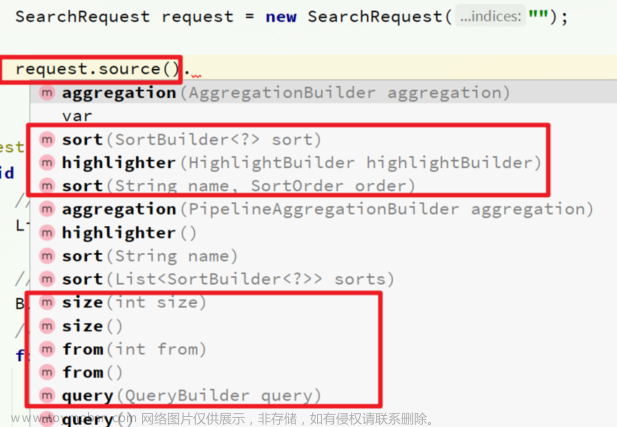前言:上文介绍了使用DSL语言操作索引库和文档,本篇文章将介绍使用Java中的RestClient来对索引库和文档进行操作。
希望能够加深自己的印象以及帮助到其他的小伙伴儿们😉😉。
如果文章有什么需要改进的地方还请大佬不吝赐教👏👏。
小威在此先感谢各位大佬啦~~🤞🤞

🏠个人主页:小威要向诸佬学习呀
🧑个人简介:大家好,我是小威,一个想要与大家共同进步的男人😉😉
目前状况🎉:24届毕业生,曾经在某央企公司实习,目前在某税务公司实习👏👏💕欢迎大家:这里是CSDN,我总结知识的地方,欢迎来到我的博客,我亲爱的大佬😘
以下正文开始

好,那就详细记录下这块的知识。
前面记录了在网页端使用DSL语句对Elasticsearch的索引库和文档进行增删改查的简单操作。但是在日常的开发工作中,还是用Java语言操作比较多,因此需要使用Elasticsearch官方提供的RestClient操作索引库和文档。
首先准备一个索引库名为hotel的库并分析其中字段的数据结构,然后根据字段的名称,数据类型,是否参与搜索,是否分词,分词器等条件来完善其mapping,在其内部定义了一个名为“all”字段的属性,这个字段目的是将其他同时参与搜索的字段cope_to在一起,搜索的时候根据“all”字段内的查询条件一起搜索,可以提高搜索效率:
PUT /hotel
{
"mappings": {
"properties": {
"id":{
"type": "keyword"
},
"name":{
"type": "text",
"analyzer": "ik_max_word",
"copy_to": "all"
},
"address":{
"type": "keyword",
"index": false
},
"price":{
"type": "integer"
},
"score":{
"type": "integer"
},
"brand":{
"type": "keyword",
"copy_to": "all"
},
"city":{
"type":"keyword"
},
"starName":{
"type": "keyword"
},
"business":{
"type": "keyword"
, "copy_to": "all"
},
"location":{
"type": "geo_point"
},
"pic":{
"type": "keyword",
"index": false
},
"all":{
"type": "text",
"analyzer": "ik_max_word"
}
}
}
}
那么,如何在idea中操作对索引库和文档进行操作呢?
倘若我们想要使用RestClient来操作,首要任务就是引入其依赖:
<!--elasticsearch-->
<dependency>
<groupId>org.elasticsearch.client</groupId>
<artifactId>elasticsearch-rest-high-level-client</artifactId>
<version>7.12.1</version>
</dependency>
<dependency>
<groupId>org.elasticsearch.client</groupId>
<artifactId>elasticsearch-rest-high-level-client</artifactId>
</dependency>
第二步,在测试类中编写测试方法,我们需要创建RestClient对象,然后对RestClient进行初始化,当然创建完成RestClient后需要销毁,代码如下:
private RestHighLevelClient client;
@BeforeEach //创建对象初始化
void setUp() {
client = new RestHighLevelClient(RestClient.builder(
HttpHost.create("http://192.168.220.***:9200") //创建方法
));
}
@AfterEach //创建完成后销毁
void tearDown() throws IOException {
client.close();
}

RestClient操作索引库
创建索引库
这里的创建索引库方法和我们上面DSL语句的含义是一样的,虽然描述方式有所不同。
- 第一行代码创建索引库,相当于DSL语句中的PUT /hotel
- 第二行代码准备请求参数,MAPPING_TEMPLATE为创建DSL语句中的内容(除去PUT /hotel那些)
- 第三步调用client的indices()拿到操作索引库的所有方法,然后取出create方法
@Test
void testCreateIndex() throws IOException {
// 1.准备Request PUT /hotel
CreateIndexRequest request = new CreateIndexRequest("hotel");
// 2.准备请求参数
request.source(MAPPING_TEMPLATE, XContentType.JSON);//这里将DSL语句封装成了MAPPING_TEMPLATE,优雅美观
// 3.发送请求
client.indices().create(request, RequestOptions.DEFAULT);
}
可以进入indices方法的源码,查看得返回的是indicesClient,如下:
public final IndicesClient indices() {
return this.indicesClient;
}
delete的方法的源码,由此可见上面传入request请求即可:
public final class IndicesClient {
private final RestHighLevelClient restHighLevelClient;
IndicesClient(RestHighLevelClient restHighLevelClient) {
this.restHighLevelClient = restHighLevelClient;
}
public AcknowledgedResponse delete(DeleteIndexRequest deleteIndexRequest, RequestOptions options) throws IOException {
return restHighLevelClient.performRequestAndParseEntity(deleteIndexRequest, IndicesRequestConverters::deleteIndex, options,
AcknowledgedResponse::fromXContent, emptySet());
}
}
删除索引库
根据以上信息,我们不难得出使用RestClient删除索引库和判断索引库是否存在的相关代码:
@Test //判断索引库是否存在
void testExistsIndex() throws IOException {
// 1.准备Request,注意这块是获取索引库请求而不是创建
GetIndexRequest request = new GetIndexRequest("hotel");
// 3.发送请求,调用exists方法
boolean isExists = client.indices().exists(request, RequestOptions.DEFAULT);
System.err.println(isExists ? "索引库存在" : "索引库不存在");
}
@Test //删除索引库操作
void testDeleteIndex() throws IOException {
// 1.准备Request,指定删除哪个索引库
DeleteIndexRequest request = new DeleteIndexRequest("hotel");
// 3.发送请求,调用delete方法
client.indices().delete(request, RequestOptions.DEFAULT);
}
综上所述,索引库操作的基本步骤:
• 初始化RestHighLevelClient
• 创建XxxIndexRequest。Xxx可以是Create,Get,Delete
• 准备DSL语句( Create时需要)
• 发送请求。调用RestHighLevelClient#indices().xxx()方法,xxx可以是create,exists,delete
RestClient操作文档
操作文档和操作索引库一样,需要完成RestClient的初始化和销毁操作,这里不展现重复代码了。
插入文档
前面调用MybatisPlus中查询的方法从数据库中查询出ID为61083的信息,由于索引库和数据库中的某字段不是很对应,所以做了一次转换。之后开始操作文档。
- 第一步,创建文档,与POST /索引库名称/_doc/1相对应
- 第二步,准备json文档,上部代码已经对数据json序列化了
- 第三步,直接调用index方法发送请求
private RestHighLevelClient client;
@Autowired
private IHotelService hotelService;
@Test
void testAddDocument() throws IOException {
// 1.查询数据库hotel数据
Hotel hotel = hotelService.getById(61083L);
// 2.转换为HotelDoc
HotelDoc hotelDoc = new HotelDoc(hotel);
// 3.转JSON
String json = JSON.toJSONString(hotelDoc);
// 1.准备Request
IndexRequest request = new IndexRequest("hotel").id(hotelDoc.getId().toString());//索引库中对id的要求为"keyword",因此要转换成string类型
// 2.准备请求参数DSL,其实就是文档的JSON字符串
request.source(json, XContentType.JSON);
// 3.发送请求
client.index(request, RequestOptions.DEFAULT);
}
查询文档
根据id查询文档信息,相对应的DSL语句为:GET /数据库名称/_doc/1。查询是新建GetRequest对象。
@Test
void testGetDocumentById() throws IOException {
// 1.准备Request // GET /hotel/_doc/{id}
GetRequest request = new GetRequest("hotel", "61083");
// 2.发送请求
GetResponse response = client.get(request, RequestOptions.DEFAULT);
// 3.解析响应结果
String json = response.getSourceAsString();
//查询出来的对象是json形式,这里转换成HotelDoc对象形式
HotelDoc hotelDoc = JSON.parseObject(json, HotelDoc.class);
System.out.println("hotelDoc = " + hotelDoc);
}
修改文档
前面介绍的修改有两种方式,一种为全局修改,一种为增量修改,这里以增量修改为例(DSL语句:POST /数据库名称/_doc/1):
@Test
void testUpdateById() throws IOException {
// 1.准备Request
UpdateRequest request = new UpdateRequest("hotel", "61083");
// 2.准备参数,这里是需要改变的参数
request.doc(
"price", "870"
);
// 3.发送请求
client.update(request, RequestOptions.DEFAULT);
}
文档操作的基本步骤:
• 初始化RestHighLevelClient
• 创建XxxRequest。Xxx可以是Index,Get,Update,Delete
• 准备参数(Index和Update时需要)
• 发送请求。调用RestHighLevelClient.xxx()方法,xxx可以是index,get,update,delete
• 解析结果(Get时需要,将查询出的json形式转化为对象形式)
本篇文章就先分享到这里了,后续会继续分享其他方面的知识,感谢大佬认真读完支持咯~
文章到这里就结束了,如果有什么疑问的地方请指出,诸佬们一起讨论😁
希望能和诸佬们一起努力,今后我们顶峰相见🍻
再次感谢各位小伙伴儿们的支持🤞文章来源:https://www.toymoban.com/news/detail-458385.html
 文章来源地址https://www.toymoban.com/news/detail-458385.html
文章来源地址https://www.toymoban.com/news/detail-458385.html
到了这里,关于ElasticSearch之RestClient操作索引库和文档的文章就介绍完了。如果您还想了解更多内容,请在右上角搜索TOY模板网以前的文章或继续浏览下面的相关文章,希望大家以后多多支持TOY模板网!













